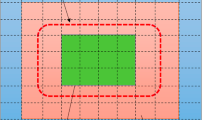Abstract
While solving real-world transportation problems, a decision-maker has to face the uncertainty and/or hesitations to define the input parameters. To deal with such situations, rough set theory is a significant tool as it includes the agreement and understanding of all the experts. In this study, a mathematical model of fractional transportation problem is developed in which all the coefficients and decision variables are rough intervals. To solve the problem, a new method is proposed in which the problem model is decomposed into two sub-models: the upper interval model and the lower interval model. These two sub-models are further solved to get the optimal rough interval solution. At last, a numerical example is solved to demonstrate the applicability of the proposed methodology in the areas of transportation and decision-making.
Access this chapter
Tax calculation will be finalised at checkout
Purchases are for personal use only
Similar content being viewed by others
References
Hitchcock FL (1941) The distribution of a product from several sources to numerous localities. J Math Phys 20(1):224–230. https://doi.org/10.1002/sapm1941201224
Ahmed MM, Khan AR, Uddin MS, Ahmed F (2016) A new approach to solve transportation problems. Open J Optim 5(1):22–30. https://doi.org/10.4236/ojop.2016.51003
Amaliah B, Fatichah C, Suryani E (2022) A new heuristic method of finding the initial basic feasible solution to solve the transportation problem. J King Saud Univ Comput Inf Sci 34(5):2298–2307. https://doi.org/10.1016/j.jksuci.2020.07.007
Amaliah B, Fatichah C, Suryani E (2022) A supply selection method for better feasible solution of balanced transportation problem. Expert Syst Appl 203:117399. https://doi.org/10.1016/j.eswa.2022.117399
Karagul K, Sahin Y (2020) A novel approximation method to obtain initial basic feasible solution of transportation problem. J King Saud Univ Eng Sci 32(3):211–218. https://doi.org/10.1016/j.jksues.2019.03.003
Swarup K (1966) Transportation technique in linear fractional functional programming. J R Naval Sci Serv 21(5):256–260
Gupta A, Khanna S, Puri M (1993) A paradox in linear fractional transportation problems with mixed constraints. Optimization 27(4):375–387. https://doi.org/10.1080/02331939308843896
Khurana A, Arora S (2006) The sum of a linear and a linear fractional transportation problem with restricted and enhanced flow. J Interdiscip Math 9(2):373–383. https://doi.org/10.1080/09720502.2006.10700450
Joshi VD, Gupta N (2011) Linear fractional transportation problem with varying demand and supply. Le Matematiche 66(2):3–12. https://doi.org/10.4418/2011.66.2.1
Zadeh L (1965) Fuzzy sets. Inf Control 8(3):338–353
Anukokila P, Radhakrishnan B (2019) Goal programming approach to fully fuzzy fractional transportation problem. J Taibah Univ Sci 13(1):864–874. https://doi.org/10.1080/16583655.2019.1651520
Bhatia TK, Kumar A, Sharma MK (2022) Mehar approach to solve fuzzy linear fractional transportation problems. Soft Comput 26:11525–11551. https://doi.org/10.1007/s00500-022-07408-x
Khalifa HAEW, Kumar P, Alharbi MG (2021) On characterizing solution for multi-objective fractional two-stage solid transportation problem under fuzzy environment. J Intell Syst 30(1):620–635. https://doi.org/10.1515/jisys-2020-0095
Liu ST (2016) Fractional transportation problem with fuzzy parameters. Soft Comput 20(9):3629–3636. https://doi.org/10.1007/s00500-015-1722-5
Atanassov K (1986) Intuitionistic fuzzy sets. Fuzzy Sets Syst 20(1):87–96
Anukokila P, Anju A, Radhakrishnan B (2019) Optimality of intuitionistic fuzzy fractional transportation problem of type-2. Arab J Basic Appl Sci 26(1):519–530. https://doi.org/10.1080/25765299.2019.1691895
Bharati SK (2019) Trapezoidal intuitionistic fuzzy fractional transportation problem. In: Soft computing for problem solving, pp 833–842. https://doi.org/10.1007/978-981-13-1595-4-66
El Sayed M, Abo-Sinna MA (2021) A novel approach for fully intuitionistic fuzzy multi-objective fractional transportation problem. Alex Eng J 60(1):1447–1463. https://doi.org/10.1016/j.aej.2020.10.063
El Sayed MA, El-Shorbagy MA, Farahat FA, Fareed AF, Elsisy MA (2021) Stability of parametric intuitionistic fuzzy multi-objective fractional transportation problem. Fract Fract 5(4):233–250. https://doi.org/10.3390/fractalfract5040233
Pawlak Z (1982) Rough sets. Int J Comput Inf Sci 11(5):341–356
Rebolledo M (2006) Rough intervals enhancing intervals for qualitative modeling of technical systems. Artif Intell 170(8):667–685. https://doi.org/10.1016/j.artint.2006.02.004
Bouzayane S, Saad I (2020) A multi-criteria approach based on rough set theory for the incremental periodic prediction. Eur J Oper Res 286(1):282–298. https://doi.org/10.1016/j.ejor.2020.03.024
Ruidas S, Seikh MR, Nayak PK (2021) A production-repairing inventory model considering demand and the proportion of defective items as rough intervals. Oper Res 22:2803–2829. https://doi.org/10.1007/s12351-021-00634-5
Seikh MR, Dutta S, Li DF (2021) Solution of matrix games with rough interval pay-offs and its application in the telecom market share problem. Int J Intell Syst 36(10):6066–6100. https://doi.org/10.1002/int.22542
Sharma HK, Kumari K, Kar S (2020) A rough set theory application in forecasting models. Decis Mak Appl Manag Eng 3(2):1–21. https://doi.org/10.31181/dmame2003001s
Stankovic M, Gladovic P, Popovic V (2019) Determining the importance of the criteria of traffic accessibility using fuzzy AHP and rough AHP method. Decis Mak Appl Manag Eng 2(1):86–104. https://doi.org/10.31181/dmame1901086s
Bera S, Giri PK, Jana DK, Basu K, Maiti M (2018) Multi-item 4D-TPs under budget constraint using rough interval. Appl Soft Comput 71:364–385. https://doi.org/10.1016/j.asoc.2018.06.037
Midya S, Roy SK (2020) Multi-objective fixed-charge transportation problem using rough programming. Int J Oper Res 37(3):377–395
Bera RK, Mondal SK (2020) Credit linked two-stage multi-objective transportation problem in rough and bi-rough environments. Soft Comput 24(23):18129–18154. https://doi.org/10.1007/s00500-020-05066-5
Garg H, Rizk-Allah RM (2021) A novel approach for solving rough multi-objective transportation problem: development and prospects. Comput Appl Math 40(4):1–24. https://doi.org/10.1007/s40314-021-01507-5
Shivani, Rani D, Ebrahimnejad A (2022) An approach to solve an unbalanced fully rough multi-objective fixed-charge transportation problem. Comput Appl Math 41(4):1–27. https://doi.org/10.1007/s40314-022-01830-5
Xu J, Tao Z. Rough multiple objective decision making. CRC Press Taylor and Francis Group. http://www.copyright.com/
Acknowledgements
The first author is thankful to the Ministry of Human Resource Development, India, for providing financial support, to carry out this work.
Author information
Authors and Affiliations
Corresponding author
Editor information
Editors and Affiliations
Ethics declarations
Conflict of Interest All the authors declare that they have no conflict of interest.
Ethical Approval This article does not contain any studies with human participants or animals performed by any of the authors.
Rights and permissions
Copyright information
© 2023 The Author(s), under exclusive license to Springer Nature Singapore Pte Ltd.
About this paper
Cite this paper
Shivani, Rani, D. (2023). A Method to Solve Fractional Transportation Problems with Rough Interval Parameters. In: Kumar, R., Verma, A.K., Sharma, T.K., Verma, O.P., Sharma, S. (eds) Soft Computing: Theories and Applications. Lecture Notes in Networks and Systems, vol 627. Springer, Singapore. https://doi.org/10.1007/978-981-19-9858-4_59
Download citation
DOI: https://doi.org/10.1007/978-981-19-9858-4_59
Published:
Publisher Name: Springer, Singapore
Print ISBN: 978-981-19-9857-7
Online ISBN: 978-981-19-9858-4
eBook Packages: Intelligent Technologies and RoboticsIntelligent Technologies and Robotics (R0)




